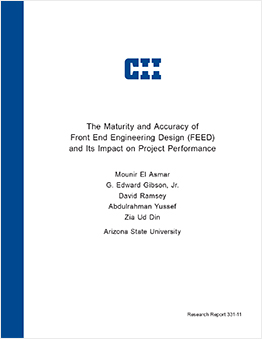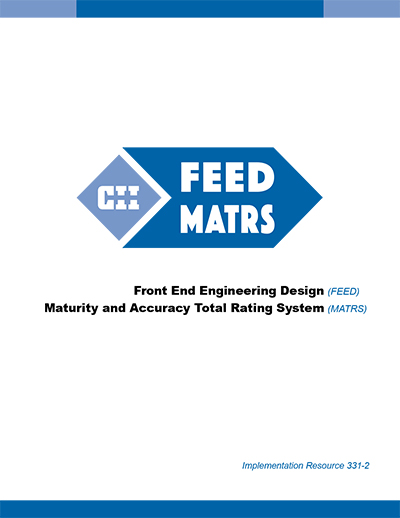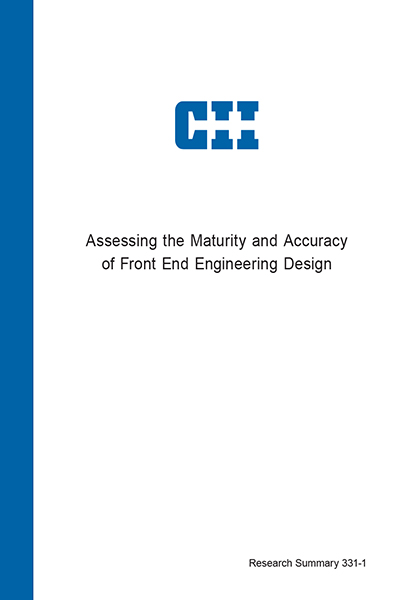
The Maturity and Accuracy of Front End Engineering Design (FEED) and Its Impact on Project Performan
Assessing the maturity and accuracy of front end engineering design (FEED) to support Phase Gate approvals for large industrial projects is a critical task with significant influence on overall project success. This research report provides a detailed account of the work of Construction Industry Institute (CII) Research Team (RT) 331, Assessing the Maturity and Accuracy of Front End Engineering Design to Support Phase Gate Approvals, culminating in the development of the FEED Maturity and Accuracy Total Rating System (FEED MATRS) tool, pronounced “feed matters.” This report provides the motivation, methodology, data analysis, research findings (which include significant correlations between the maturity and accuracy of FEED and project performance), applicability and importance to the industry. The results presented in this report are based on input from 128 individuals in 57 organizations and a data sample of 33 completed and 11 on-going large industrial projects representing over $13.9 billion of total installed cost.
In the initial part of this research effort, the team developed a standard definition of FEED based on the input of 80 survey responses from 33 organizations. FEED is defined as “a component of the front end planning (FEP) process performed during detailed scope (phase 3), consisting of the engineering documents, outputs, and deliverables for the chosen scope of work.”
One major deliverable from this research is FEED MATRS, a tool that generates two separate scores for a project; a maturity score and an accuracy score, which are each normalized to a 0-100 scale and are plotted on a maturity-accuracy matrix. The maturity-accuracy matrix is divided into four quadrants and gives the users a high-level understanding of where their project stands in terms of maturity and accuracy at the end of the detailed scope phase (Phase Gate 3), with direct implications on project cost and change performance.
The maturity assessment component of FEED MATRS consists of 46 engineering elements presented in a weighted checklist format. The tool provides a method for quantifying the level of maturity of the engineering design effort during FEED at the end of detailed scope (Phase Gate 3). The tool’s weighted index, derived from the Project Definition Rating Index (PDRI)-Industrial, allows users to measure the level of maturity of the FEED deliverables and correlate this maturity score with project performance outcomes.
Similarly, the accuracy assessment component of FEED MATRS consists of 27 FEED accuracy factors and is also presented in a weighted checklist format. This novel assessment method provides, for the first time, a method for evaluating contextual or external factors associated with the environment in which FEED is developed. FEED accuracy factors were derived from a number of past CII research efforts, a comprehensive literature review, and through extensive industry input. This effort set the stage for several industry workshops in which the research team and 48 collaborating industry experts developed weights for the accuracy assessment component of FEED MATRS.
The research found that projects with high FEED maturity and accuracy outperformed projects with low FEED maturity and accuracy by 24 percent in terms of cost growth, and 12 percent in terms of change order performance, in relation to the approved budget at Phase Gate 3. Projects with high FEED maturity and accuracy also outperformed those with low maturity and low accuracy in terms of financial performance and customer satisfaction matching expectations.
The resulting tool was tested by eight different organizations on eleven in-progress projects actively involved in the front end planning process. Data from these assessments showed that FEED MATRS provided the project teams with an understanding of FEED development risks, helped project team members identify critical gaps, and added considerable value to the FEED effort on the projects.
In summary, the test results from this study are clear. There is no mystery and there are no shortcuts to performing well on capital projects. Indeed, this study presents additional evidence that the phase gated approach to front end planning works and results in successful projects. Excellent project results occur when project teams are put in the right environment to succeed and when they pursue front end engineering to a mature and accurate state. The results from this study, although on a relatively small sample show these facts conclusively and validate over 25 years of research conducted in this area by CII. However, even though this knowledge exists, many organizations are not fully making use of it. Professional education and implementation of known research findings are arguably what is needed for the industry to take its next big leap.



